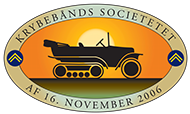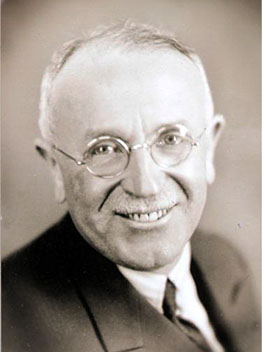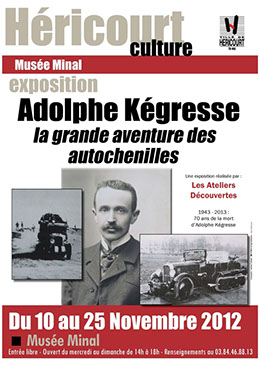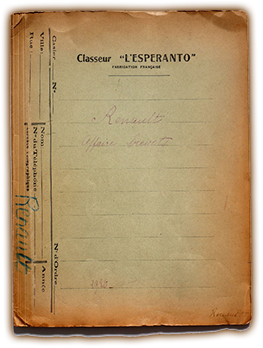

Kegresse.dk
Adoplphe Kégresse
Most of the text is from the catalog from the exhibition on Adolphe Kégresse at the Musée Minal in Héricourt
during 10-25 Novembre 2012.
The youth
Adolphe Kégresse was born on June 20, 1879 in Héricourt.
The Kégreisz family has its origins in Germany, in Bad Württemberg, south of Stuttgart. The family moved to Alsace, then to Héricourt.
Adolphe's parents are well off: his father Gustave is a director from a Noblot spinning mill and his mother, born Sophie Emilie Buchler, owns a fabric shop at 12 Grande Rue (today rue du General de Gaulle).
Adolphe is the last born of a family of 7 children, all born in Héricourt, of which only 4 survived: Adèle (1864-1952), Gustave (1866-1908), Sophie (1871-?) and Adolphe (1879-1943).
Very young, Adolphe showed a passion for mechanics, and in particular for automobile mechanics, which was then expanding. After primary school, he goes to school practice of industry of Huisselets in Montbéliard and at 16 years old, he obtains his certificate of professional aptitude in the test practice of fitting and turning on metals.
Upon leaving military service, he was hired by Louis Jeanperrin in Glay (Doubs) which built engines. He is very fast appointed workshop manager.
The Russian Adventure
Dreaming of a change of scenery and new worlds, he emigrates in Russia in 1903. In Saint Petersburg, he got a job as master mechanic at the Russian Railways. He is noticed by prince Orlov, head of the military chancellery of Tsar Nicolas II, when he managed to unlock a switch frozen which immobilizes the imperial train. A few days later, he is hired as an engineer in the imperial garages. In 1905, he was appointed technical director of the whole of the Tsar's automobile services..
But a problem preoccupies Kégresse: as soon as the snow and ice, cars become unusable. He is looking So a way to fix this problem. He invented the automobile sled, the first tracked car flexible carriers, which will later become the autochenile. He deposits the patent on May 7, 1913.
In 1904, he married Hélène Moniakoff. Three children were born to this union: Sonia, Elisabeth and Adolphe.
To improve the mobility of the imperial car park, he invented the Kégresse track to modify normal motor vehicles into half-tracks. He was also a personal chauffeur of Tsar Nicholas II and the Head of the Mechanical Department of the Russian Imperial Garage at Tsarskoye Selo. The Aide-de-camp to Tsar Nicholas II, Prince Orlov wrote in a letter to the Tsar's Minister of the Court on May 15, 1914:
"... I consider Kégresse an irreplaceable worker and I am afraid his leaving will be a great loss for the garage. Your Highness knows, of course, how much His Majesty appreciates Kégresse."
In 1908, the architect Lipsky VA designed a second two-storeyed Art Nouveau building for the Russian Imperial garage at Tsaskoye Selo / Pushkin, Saint Petersburg it had a total area of 367.6 sq. M. It housed the garage-residence Adolphe Kégresse. The building is noteworthy and identifiable for inclusion of a grand staircase with an external bas-relief image of one of the first car races held regularly in Tsarskoe Selo before the First World War.
In 1917, when the Russian Revolution broke out, he fled the country for the Finland with his family, then returned to France.
The meeting with Citroën
Without money and without work, provided only with the patent of the half-track, he tells his difficulties to Georges Schwob, son of the founder of a spinning and weaving house in Héricourt, and who is also president of the Citroën gear company. Georges Schwob introduces Adolphe to Jacques Hinstin, the partner of André Citroën (1878-1935) in this gear company which they founded together in 1913, quai de Javel in Paris.
Hinstin proposes to Kégresse to equip some half-tracks Citroen cars.
In October 1920, they presented these cars to André Citroën himself. The latter immediately grasped the importance of the invention of Kégresse and the benefits he might derive from it. In 1920, a patent is registered in the name of "Kégresse-Hinstin" for half-tracks, and a three-party agreement is signed between Citroën, Kégresse and Hinstin for their operation.
A "Autochenilles" department was created on the quai de Javel; Adolphe Kégresse was appointed technical director and could then work their improvement. Citroën is embarking on several advertising operations large scale to showcase the half-tracks. These promotional campaigns will have an international impact.
After leaving the Citroën company he developed in 1935 the Auto Serve gearbox-transmission system.
In 1939 he pioneered the development of modern small guided tracked bombs "Goliath".
Kégresse died in 3 février 1943 at Croissy-sur-Seine. Haute-Saône

Agreements between M.M. A. Citroën, A. Kégresse and Ets. Jacques Hinstin
Typed correspondence with handwritten annotations between Adolphe Kégresse, Jacques Hinstin and André Citroën.
It includes 19 letters gathered in a leather folder which summarize the agreements between the three parties concerning the transfer of the exclusive license of all the patents of Adolphe Kégresse concerning the propulsion of vehicles.
Credits: Musée des Cordeliers, Saint-Jean-d'Angély
Typed correspondence with handwritten annotations between Adolphe Kégresse and Louis Renault.
It includes 17 letters gathered in a cardboard binder which summarize the exchanges between the two parties on the subject of the load distribution system on the track built by Renault, of which Kégresse claims ownership.
Credits: Musée des Cordeliers, Saint-Jean-d'Angély





